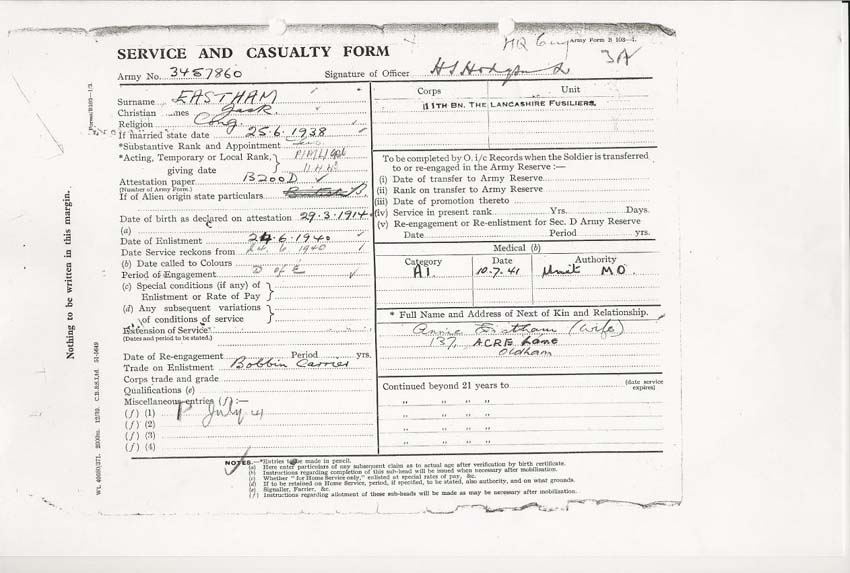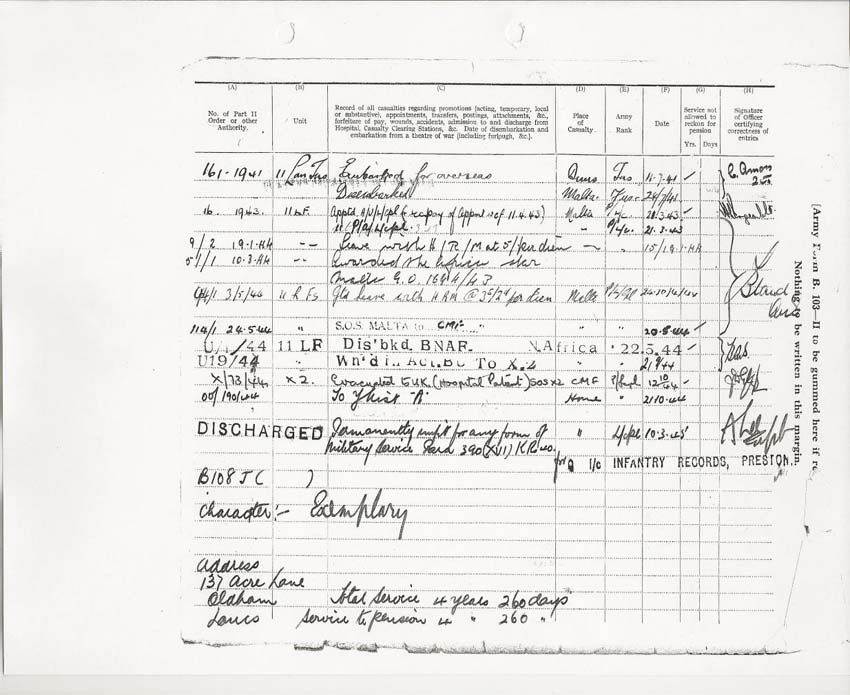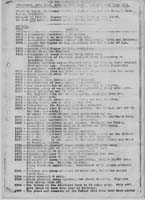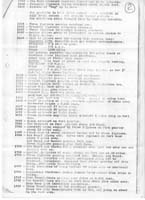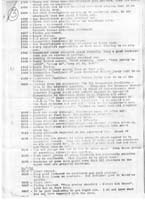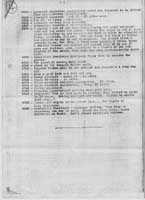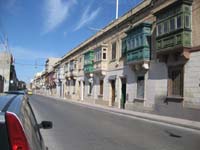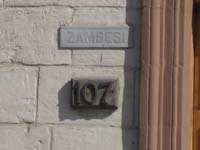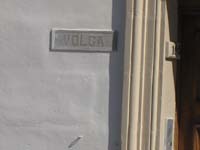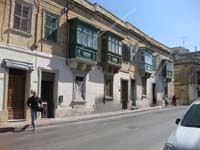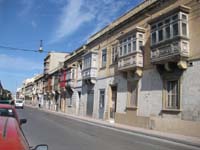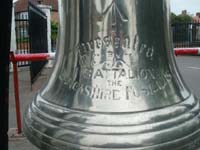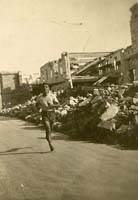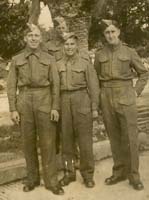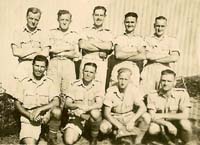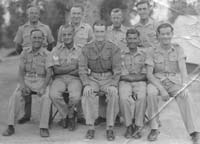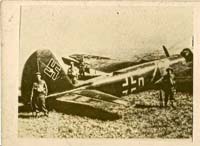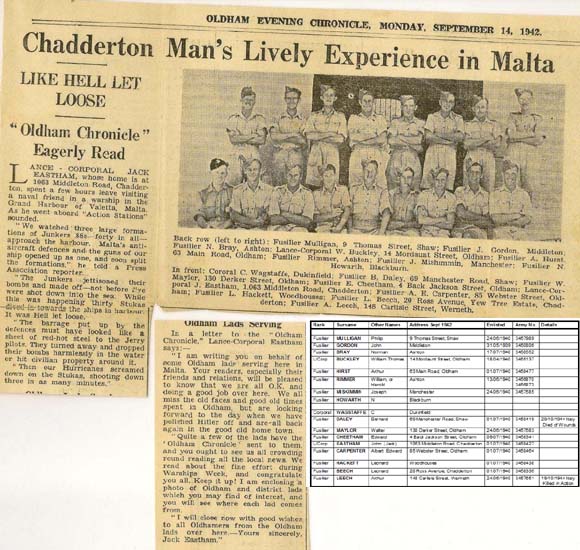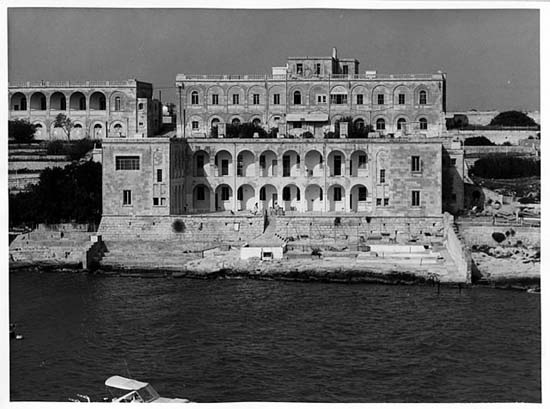By
Rodney A Eastham MSc FRICs
2011
Preface
This Document is to be read in conjunction with The Eastham Family Tree
This work is based on a considerable amount of research both in terms of the family and primarily his military service. It is not possible within the military records to identify individuals who were not officers as 'other ranks' were not mentioned unless within dispatches. This research has been compiled using some works from the 11th Battalion Lancashire Fusiliers, the War Diaries from the National Archives, Articles drawn from the Internet, The book 'Malta Diary of a War 1940 - 1945 written by Michael Galea and research on the ground in Malta. I would like to thank all those who have aided me in my quest.
Jack Eastham. He was born on 29 Mar 1914 in 10, Granville
Street, Chadderton, Nr Oldham, Lancashire, England (Birth certificate
held) the only son of John Edward Eastham and Alice Coode. He died on
26 Jun 1992 in Oldham and District General Hospital, Oldham, Lancashire,
England due to chronic renal failure (Death certificate held). He is buried
in Grave B15 Section 70, Greenacres Cemetery, Oldham, Lancashire, England.
Anne Hill is the daughter of Henry Huddlestone Hill and Emma Burgin. She
was born on 02 Jun 1917 in 3 Portland Street, Rochdale, Lancashire, England
(Birth certificate held). She died on 10 Oct 1997 in Oldham, Lancashire,
England in a Nursing Home. Cause of Death was Carcinoma Breast (Death
certificate held). She is buried in Grave B15 Section 70, Greenacres Cemetery,
Oldham, Lancashire, England.
(Note:Annie Hill was 'unofficially adopted' by an agreement between Arthur
and Alice Warburton and Henry Hudlestone Hill 'Harry' on the 14th October
1919. This was never placed on the Register of Adoption and thus was never
legally recognised. It was not till many years later that she discovered
that she had a sister, Janet). Arthur Warburton and Alice Robinson were
married about May 1912 the marriage being registered in Bury, Lancashire,
England probably taking place in Heywood, Lancashire, England. They had
no other children. Alice died about 1960 and Arthur died about 1969.
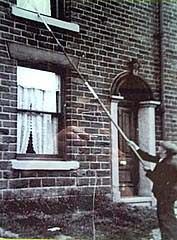 |
This was a common sight in most Northern
mill towns. The knocker up. charged people to wake them in the
morning to ensure they did not miss a days work. In many instances
they also lit the gas street lights.
|
 |
 |
 |
|
The mills of Oldham dominated the skyline
and the noise in the mill rooms was horrendous. The mill workers
suffered greatly with their health as a result of the noise and
the injuries caused by the flying shuttles and the necessary piecing
of the threads as they broke
|
Jack was employed as a bobbin carrier in a cotton mill in Oldham at the time of his marriage and this is undoubtedly where he met Annie who was working as a cotton winder. The mill was the Holyrood. John Smith and Sons commissioned the practice of Joseph Stott who was born on 25 October 1836 in Oldham, the son of James Stott and Mary Henthorn to build the Holyrood Mill, Windsor Street, Higinshaw, Oldham, Lancashire, England in 1870. Holyrood mill had 59,000 spindles but sadly was destroyed by fire in 1961
Jack Eastham and Anne Hill were married on 25 Jun 1938
in Providence Chapel, Regent Street, Oldham, Lancashire, England (Marriage
certificate held). At the time of their marriage Jack was living with
his mother, Alice nee Coode or Codd, at 1 Cheltenham Street, Oldham, Lancashire,
England, and Annie was living with her 'adopted' parents Arthur and Alice
Warburton at 101 Beever Street, Oldham, Lancashire, England. After their
marriage they went to live for a short time in Cheltenham Street and then
subsequently moved to 137 Acre Lane, Oldham, Lancashire, England by April
1940 when Jack was called up to the army and they remained there until
their deaths.
Military Service
This account is based on the War Diaries and official history of the 11th
Battalion the Lancashire Fusiliers and other documents issued to Jack
Eastham. Because of the nature of reporting, records were not kept as
to which company he was in and thus suffice it to say that whilst not
being specifically mentioned he was a part of this period of history
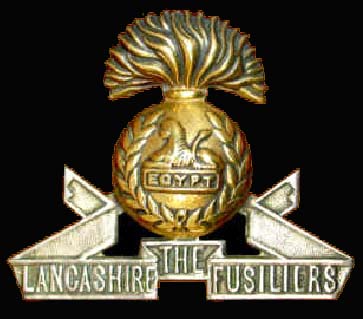 |
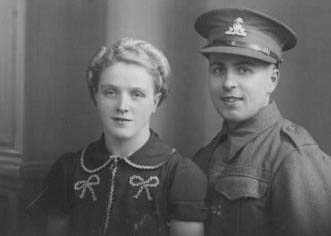 Anne Hill – Jack Eastham August 1940 |
On his enlistment the details of his identification
were as followsas given in his pay book:
Army Number 3457860
Height 5ft 3.25in
Weight 110.5lbs
Blood Group B3 (classification because of Agglutination - the clumping
together of antigens, such as red blood cells or bacteria, to form larger,
visible clumps, under the influence of antibodies).
Eyes Brown
Hair Dark Brown
Chest 33.5in fully expanded
2.5in range of expansion
Distinguishing Mark Scar to back of head
Given below is a copy of his National Service Grade Card:
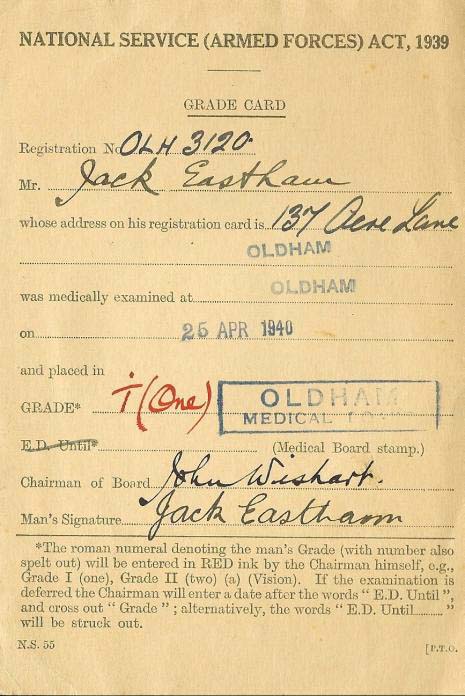 |
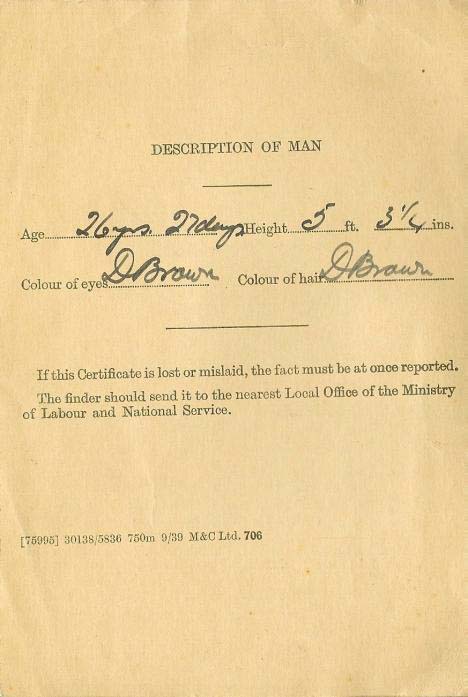 |
|
|
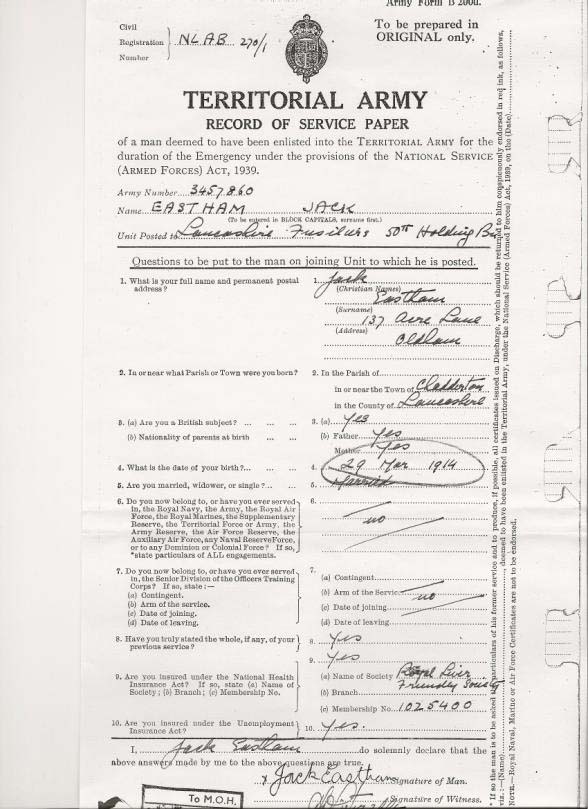 |
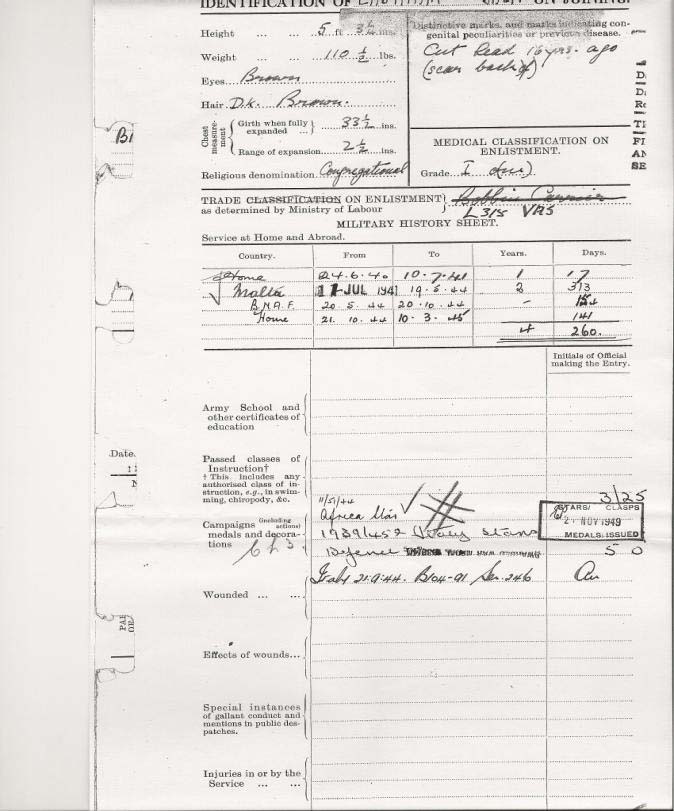 |
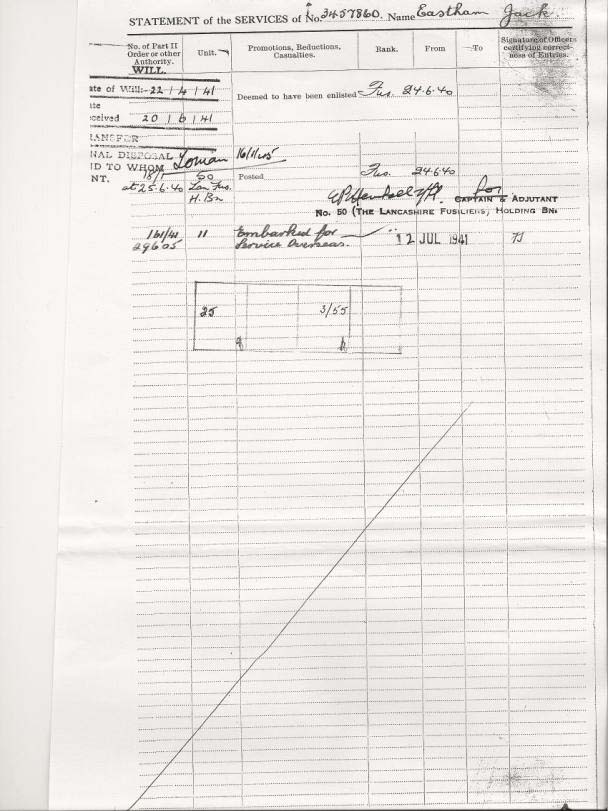 |
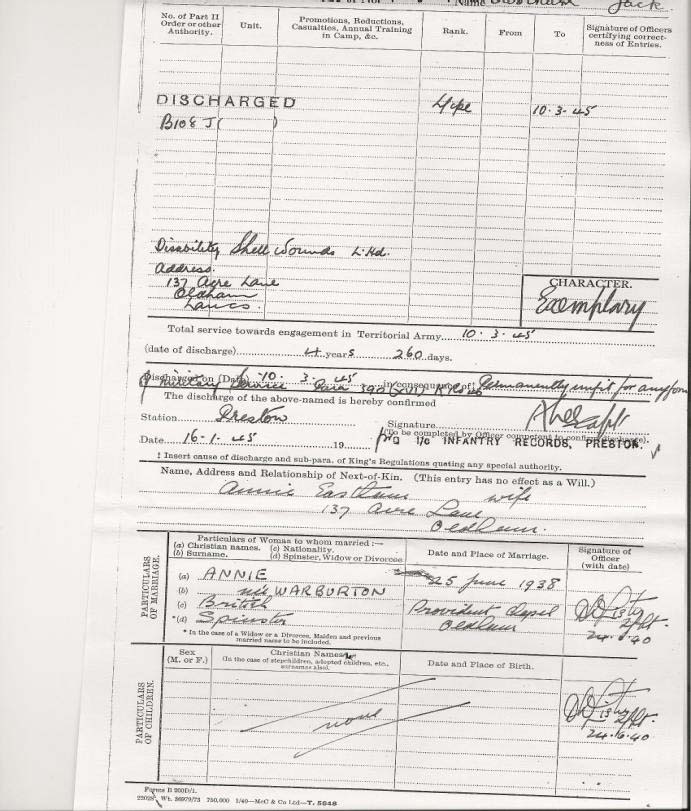 |
On the 14th October 1940 the 11th Battalion Lancashire
Fusiliers was formed in Rochdale out of the 50th Holding Battalion under
the command of Lieutenant Colonel R.C. Harris. Its first move was to Boulton
Mill, Dursley in Gloucestershire where it assisted the people of Bristol
during the intensive German bombing raids. In November 1940 the 11th Battalion
strength was listed as:
|
Officers
|
26
|
W.O.1
|
1
|
|
W.O.2
|
5
|
W.O.3
|
1
|
|
C/Sgts
|
5
|
Sgts
|
31
|
|
Cpls
|
48
|
L/Cpls
|
32
|
|
Fusiliers
|
836
|
On the 25/26 March 1941 the Battalion moved to Scotland and was attached to the 51st Highland Division being billeted in The Cruden Bay Hotel, The Masonic Hall Peterhead and The Drill Hall Frazerburgh. Their role was one of defence and during the time here they saw some action from isolated raids by enemy bombers.
On 17 May 1941 the Battalion moved to Pollock Camp, Glasgow for mobilisation overseas. Mobilisation continued and on 11 June 1941 the Battalion moved from Pollock Camp, Glasgow to Langton Camp, Duns in Berwickshire. All personnel were granted 1 week embarkation leave.
Central Mediterranean Area

By an accident of nature Malta lay athwart the supply routes from Italy to North Africa, which gave Britain air and sea control over Italy's Mare Nostrum ( the Mediterranean).
Malta
In September 1939 Malta found itself at war by default,
through its association with Britain. At that time the political spectrum
in Malta was sharply drawn between Nationalist party members who identified
closely with Italian values and culture, and Constitutionalists voters
who tolerated, or benefited from British colonial rule. Viewed as an internal
threat by the British, prominent people with declared sympathy for the
Italian cause were placed in North African concentration camps for the
duration of hostilities. The possibility of widespread civilian strife
or uprising by Axis sympathizers at war's onset struck fear with local
authorities, but it neverhappened. Whatever kinship the Maltese held for
Italy came to an abrupt end in 1940 when incredibly the Italian air force
indiscriminately bombed civilian targets, causing death, causalities and
property destruction.

For Malta, Monday 10th June was a significant day asat 7 pm Mussolini made his declaration of war at the Palazzo Venezia in Rome. HE Lieutenant-General William George Sheddon Dobbie mad a radio broadcast to the people of Malta asking for the utmost calm and for themto trust in God.
The first raids on Malta came at 6.25 a.m. on June 11th 1940 when there were 8 raids by German Luftwaffe. 60,000 to 80,000 people fled the Grand Harbour area. There were only 5 shelters which were in the Three Cities area. In October 1940 Grand Admiral Erich Raeder, C-in-C of the German navy proposed the occupation of Malta to the Fuhrer, which was declined. By 1941 Malta was under severe air bombardment by the German X Air Corps under General Seisler operating from Sicilian air bases, some 93 km away. The Maltese people were defiant and in Valetta they watched as members of the Italian community were detained and interned and were even more delighted when all Talian shipping in Maltese waters was seized. The 12th June recorded the first casualties of the war when members of the Royal Malta Artillery gave their lives in defence of their island. The 3rd September saw the first convoy since the start of hostilities brought into the Grand Harbour. The raids continued and on 22nd September Lord Beaverbrook, Minister of Aircraft Production, in a message to Malta said "The world needs no proof of your people's devotion to our common caise, but it will never forget their valout and constancy in these days of crisis". The 12th October saw another successful docking of 4 merchant ships with essential supplies and this was repeated on 12th November. The year ended with a bombing raid which damaged Government buildings
To say Malta's air defences were small at the beginning of WWII would be an understatement. The total air power on Malta consisted of 4 Gloster Gladiator biplanes. These were packed in crates & left at Kalafrana flying boat base by HMS Glorious which left to join the Norwegian campaign. In fact, there were enough parts to make up 8 biplanes but the Navy wanted 4 back to join the aircraft carrier HMS Eagle. The remaining 4 were assembled, 3 were to be used on operations with the remaining 1 kept in reserve. After assembling the biplanes the Royal Navy decided on having them back for work in Alexandria, so they were taken apart for re-packing. Following talks between Air Commodore Maynard & the Royal Navy it was decided to leave the biplanes on Malta & they were re-assembled. Their first use in combat came at 0649 on the 11th of June 1940 when 10 Italian Savoia Marchetti 79 bombers bombed Grand Harbour. No aircraft were shot down in this encounter. On the 7th raid of the day the Gladiator's drew blood by shooting down a Macchi 200 fighter. Although the biplanes were slower than the Italian fighters they were more manoeuvrable. Flying Officer John Waters nicknamed the aircraft 'Faith, Hope & Charity'. Three bladed propellers were fitted in place of the usual two to give the biplanes a faster rate of climb. Other parts were later used from a Swordfish. Superchargers were left on maximum during the climb after take off (which was against orders) so they could gain height faster. This put extra strain on the engines & 2 of them blew pistons. Maintenance crews converted Blenheim bomber engines to fit the Gladiators. Faith, Hope & Charity fought for 17 days without relief & played a fundamental role in fooling the Italian intelligence into thinking Malta had a substantial fighter defence.
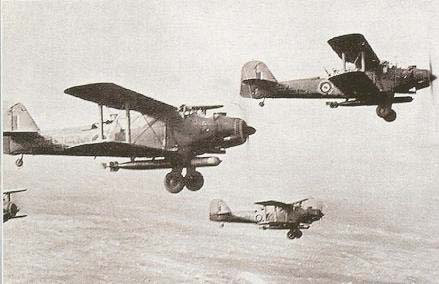 Bi Planes in the sky over Malta |
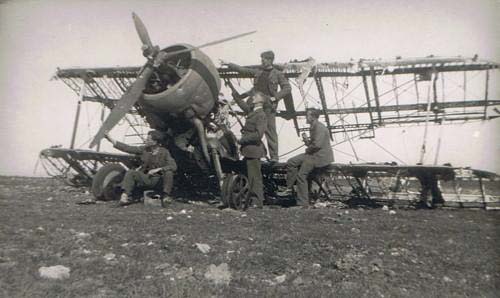 Hope destroyed by Germans 04 February 1941 Hal Far |
The Battalion marched from the camp accompanied by the band and were taken by lighter to the 36000 ton French liner 'Louis Pasteur' and on the 11th July 1941 the 11th Battalion under the command of Lt Col G F Page, sailed from Greenock on the River Clyde to an unknown destination, Code 'Z', and after 7 days with the Atlantic Convoy they arrived in Gibraltar. This was to be the end of luxury for a significant length of time for they were about to embark to an island garrison which would suffer a major onslaught. Jack Eastham's recollection was the injections in each arm given to the soldiers as the boarded the ship.
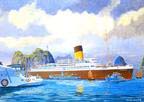 Cruise Liner 'Louis Pasteur' Converted to Troop Carrier |
They had six hours to disembark and re-embark with all battalion stores and weapons onto the cruiser HMS Edinburgh, The main body of the Battalion were aboard HMS Edinburgh and C Company under Captain D W Lister to the minesweeper 'Manxman'. They were now part of the convoy 'Operation Substance'. This was the first convoy through the Mediterranean since the fall of France. The convoy sailed out into the Atlantic with the intention of passing through the Straights of Gibraltar during darkness.
Jack Eastham recalled the journey from Gibraltar to
Malta aboard the Cruiser Edinburgh a follows:
"Life aboard the Edinburgh was significantly different to that of
the Louis Pasteur. The food was basic and the ship was overcrowded with
the Battalion on board. As well as the ships armament we had the bren
guns positioned ready for action to give us something to do. The ship
was organised so that half the Battalion was on deck with the other half
'battened down' below decks. This meant that the watertight doors were
closed and that if the ship went down it was almost certain that those
below decks would drown. This arrangement was rotated so that we all took
the risk. When the attack came it was violent. The noise of the ships
guns were horrendous punctuated by the tannoy giving the sightings and
action that the enemy were undertaking. You new when a torpedo was sighted
as the vessel turned violently to avoid impact whilst the dive bombers
dropped their bombs and torpedoes from a very low height. Flying through
the flack that the ship threw at them. We were fortunate and were not
hit during a thirteen hour sustained attack. We eventually reached Malta
but only just in time as the harbour boom was lowered just as we passed
so that the German and Itallian torpedoe boats could not get into the
Grand Harbour."
The Malta Convoy 'Operation Substance' of July 1941
consisted of six fast merchant ships City of Pretoria, Deucalion, Durham,
Port Chalmers, Melbourne Star (Captain D R MacFarlane) and Sydney Star
(Captain T S Horn). Captain MacFarlane had been appointed Commodore of
the Convoy. The escort for the journey consisted of the battle-cruiser
HMS Renown, the battleship HMS Nelson, the aircraft-carrier HMS Ark Royal,
cruisers HMS Edinburgh, Manchester, Arethusa and Hermione, the cruiser
minelayer HMS Manxman and 17 destroyers with Vice Admiral Sir James Somerville
in command.
" At 10.55am on July 23rd during an air attack, the destroyer HMS
Fearless was hit by torpedo and was severely damaged, unable to continue,
she was sunk by destroyer HMS Forester. 1 offficer and 24 ratings were
killed.
" At 2.50am on July 24th there was a sudden attack by an 'E' Boat.
The Sydney Star was hit by a torpedo on the port side and began to list.
It was decided to transfer the 460 troops she was carrying to the destroyer
HMS Nester for safety. Despite having a hole 40 by 16 feet caused by the
torpedo the Sydney Star managed to limp to her destination, with her cargo
intact.
All the merchant ship of 'Operation Substance', including the Melbourne Star, arrived at Malta with their valuable cargoes.
Royal Naval Ships
|
Battleships
|
Aircraft Carriers
|
Light Cruisers
|
Cruisers
|
Destroyers
|
Minesweepers
|
|
Renown *
|
Ark Royal *
|
Hermione *
|
Edinburgh
|
Duncan *
|
Manxman
|
|
Nelson
|
Arathusa
|
Faulknor *
|
|||
|
Manchester
|
Fearless *
|
||||
|
Firedrake *
|
|||||
|
Foresight *
|
|||||
|
Forester *
|
|||||
|
Foxhound *
|
|||||
|
Fury *
|
|||||
|
Avondale
|
|||||
|
Cossack
|
|||||
|
Eridge
|
|||||
|
Farndale
|
|||||
|
Lightning
|
|||||
|
Maori
|
|||||
|
Nestor (RAAN)
|
|||||
|
Sikh
|
" Force H Turned back to Gibraltar at the Skirki Channel so as not to put capital ships at risk
Ships in the Convoy
Merchant Ships
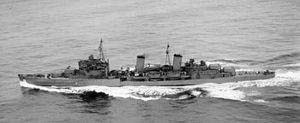 Cruiser HMS Edinburgh |
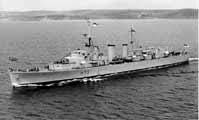 Minelayer HMS Manxman |
HMS Edinburgh served as escort during World
War 2 for the North Atlantic Convoys. On escort
duty during the Russian Convoys she was torpedoed
by Uboat U456 while escorting Convoy QP11 on
May 2 1942, she was carrying 45million in gold bullion.
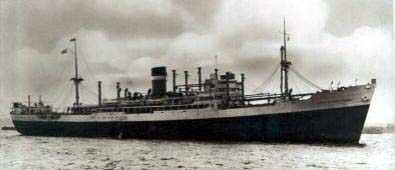 City of Pretoria |
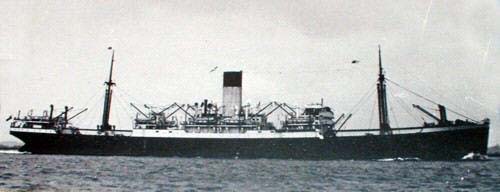 Deucalion |
 Durham |
 Sidney Star |
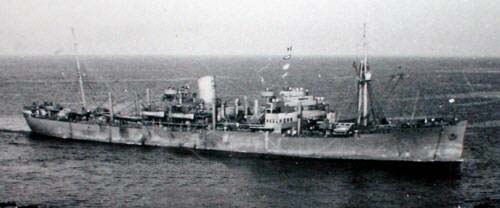 Port Chalmers |
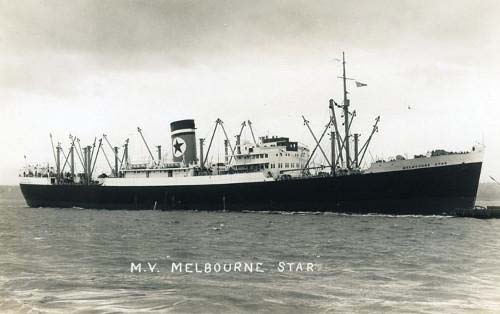 Melbourne Star |
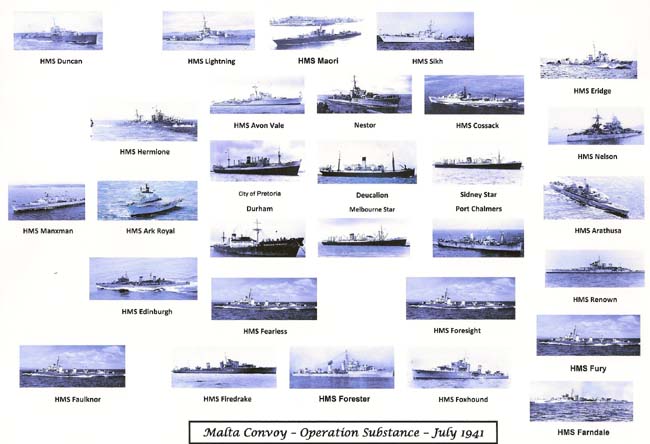 Click to enlarge |
 |
 |
 |
 |
 |
 |
 |
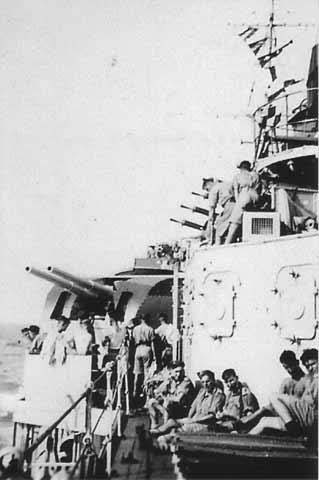 British troops on board the Minesweeper |
Sydney Star was torpedoed by an E-boat & sustained
a 40 x 20' hole in her bows. She started to sink by the head & drifted
towards the enemy held island of Pantellaria. HMS Nestor came alongside
& started evacuating the crew & 464 troops from the 32nd Light
AA Regiment. Apart from the personnel her cargo was grain, naval stores
& ammunition. It took about half an hour to transfer some 500 men.
A skeleton crew remained on board & managed to get 12 knots out of
the engines. They set coarse for Malta.
Some Savoia bombers made an attack which was driven off. Sydney Star by
this time was estimated to have shipped 7,000 tons of water & was
hard to handle. At 7 am a lone aircraft attacked with a torpedo which
exploded in the ships wake. She was joined by Hermione, Nelson & Beaufighters
from Malta & made Valletta harbour at 8 am.
HMS Firedrake received a direct hit in No. 1 boiler room from a bomb off
Cape Bon. She was taken in tow by a Hunt class destroyer & taken 800
miles to Gibraltar.
HMS Edinburgh endured 13 hours of bombing & torpedoes. She was carrying
the 11th Battalion Lancashire Fusilliers.
The convoy reached Malta on the 24th July & was greeted by reconnaissance aircraft from Sicily who brought up high level bombers to attack to convoy in harbour. This attack was broken up by the anti-aircraft barrage & Hurricanes.
The following extract is from the diaries of Bill Lazell a sergeant who served with the Royal Artillary who was part of the convoy:
Friday 11th July 1941: Arrived at Gourock in Scotland
and embarked on H.M.T.S. Pasture.
12th July : Wrote to Joy. Left port tonight. We are now out at sea. I
wonder what is in store for us?
13th-14th July : The food aboard is very good but the accommodation is
awful, it is almost impossible to sleep.
17th July : Wrote letters to Joy, Dad, Elsie and Fred.
19th July : Arrived at Gibraltar and left again 10.30pm in a mine laying
destroyer, H.M.S. Manxman.
Paddy & Rex & co. disembarked at Gib.
21st July : Saw the snow covered peaks of Sierra Nevarda mountains far
astern and was warned to expect dive bomb attacks. No attacks.
22nd July: All quiet.
23rd July : Had quite a warm time, we were attacked by dive bombers, torpedoes,
e-boats and shore batteries. We lost one destroyer one damaged and one
cruiser damaged, we shot down five planes and destroyed an e-boat.
24th July: Arrived at Malta this morning and had air raid at night, only
four bombs and no local fun
Even as they arrived at Valetta only just making it into the harbour as the boom was closing due to a submarine attack. On the 24th July 1941 at 1130 hours HMS Edinburgh sailed into the Grand Harbour at Valletta with the 11th Battalion lined up on deck and the band playing the British Grenadiers. The 11th Battalion landed at the Customs on the Grand Harbour at Valetta, Malta.
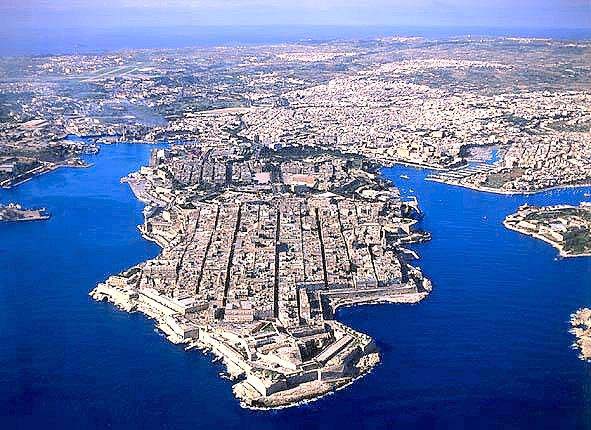 Grand and Marsamxett Harbours, Valletta. The submarine base was in Marsamxett harbour Valletta |
 Valletta and Surrounding Area |
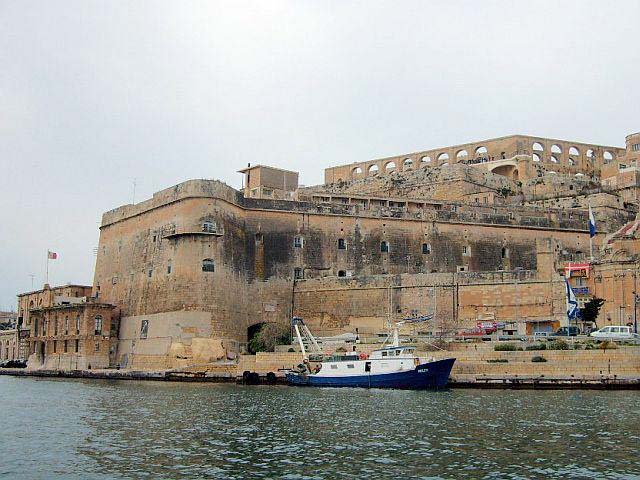 Lascaris Bastion Operation HQ |
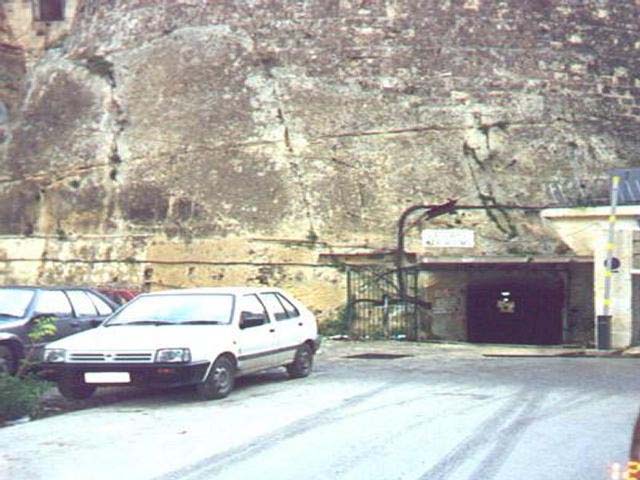 Lascaris War Rooms |
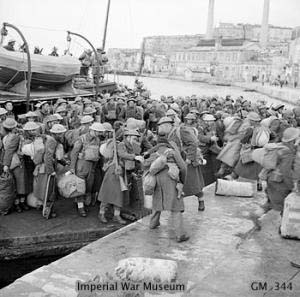 Troops come ashore at the Customs House in the GHrand Harbour in Valett |
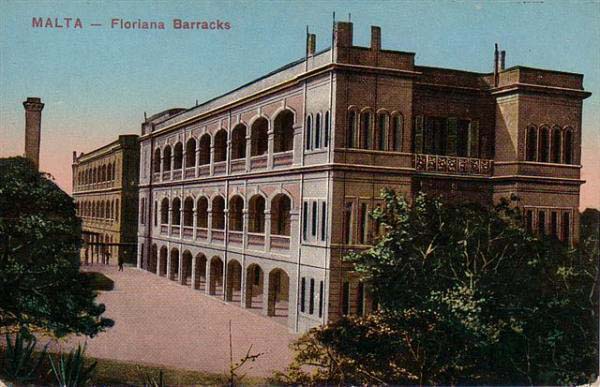
Floriana Barracks
After disembarking the 11th Battalion marched through the streets of Valetta and Floriama to their final billets in Birkirkara and Hamrun.
The barracks at Birkirkara still exist complete with the allocated names as seen below. 20 servicemen were allocated to each house.
Morale was high. They settled to their task which was mainly the defence of the city of Valetta and the immediate northern coastline from Sliema through St. Julian's Bay to St. George's Bay against invasion from sea and air. Rifle companies were not used to man coastal defences and forts but were mobile and used for operational tasks mainly at Luqa, the main RAF aerodrome and TaQali. Luqa was the largest airfield on Malta in WWII. Aircraft types operating from this base included just about every type on Malta including bombers, fighter bombers, torpedo, fighters etc. It was the first airfield in Malta to have a hard surface, all the others were grass/dirt which would become muddy in wet weather (winter). In these circumstances it was difficult to operate & all operational aircraft were moved to Luqa which made this a busy airfield.
At Luqa the 11th Battalion were mainly responsible, but not entirely so, for the defence and maintenance of the aerodrome, repairing runways, preparing dispersal bays and widening taxiways. The Battalion HQ was at Birkirkara.
The 11th Battalion served as part of Central Command
which comprised:
" 2nd Battalion Queen's Own Royal West Kent Regiment.
" 11TH BATTALION LANCASHIRE FUSILIERS
" 10th Battalion Kings Own Malta Regiment.
" 1st Battalion Cheshire Regiment (a MG battalion with 3 companies
x 3 platoons x 4 Vickers MG, plus 4th company x 4 platoons x 4 4.2"
mortars).
" Military Police Company.
The civilian population were primarily concentrated
in the towns and a significant number were located in Sliema, Valletta
and Floriana. Air raid defences were put into place which made use of
the underground ancient caves and disused railway tunnels although the
capacity was far less than that needed.
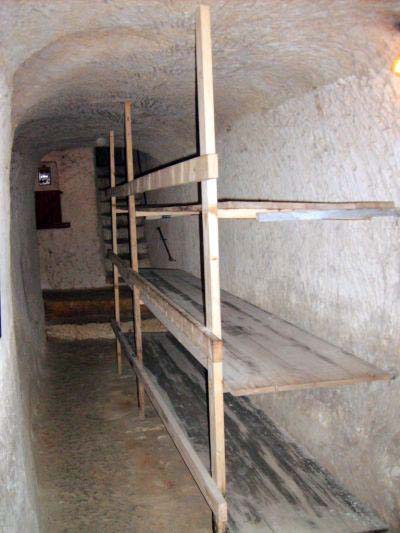 Underground Air Raid Shelter Birthing Room |
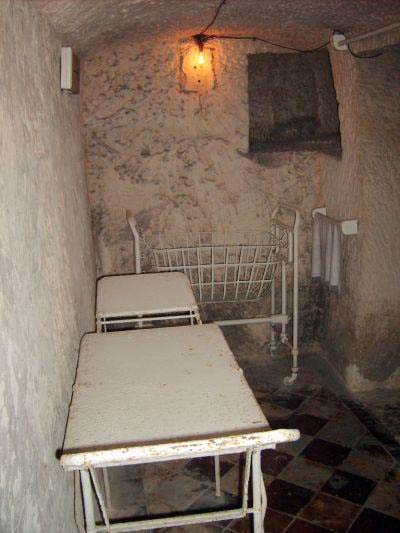 Underground Air Raid Shelter Birthing Room |
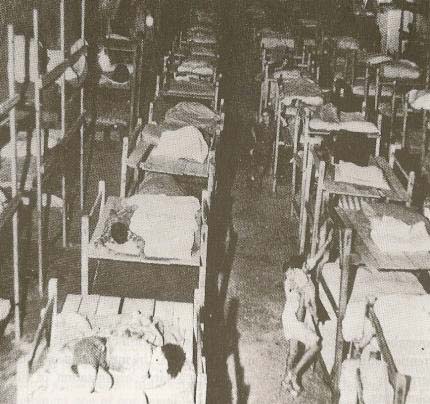 Railway Tunnel Air Raid Shelter |
Malta had a significant array of defences which had been constructed in the timesof the Templars and all they needed was the modern equipment of war.
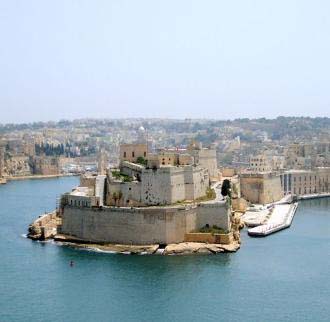 Fort St Angelo |
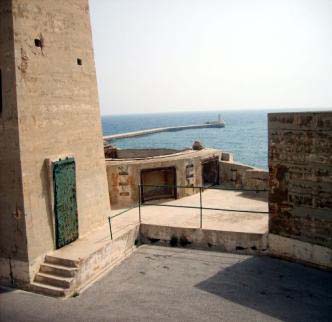 Gun Emplacement Grand Harbour Entrance |
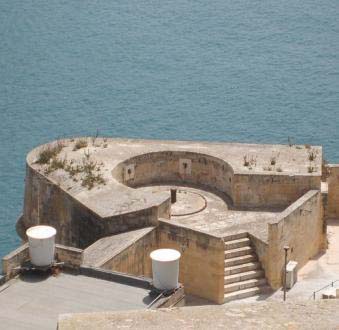 Gun Emplacement Upper Barakka Gardens |
1941
After the fall of Crete the Axis position became very strong and from
their bases in Crete, Sicily, Sardinia and Cyrenaica enemy aircraft were
able to reach out and attack any allied shipping in the area.
On the16th January 1941 the aircraft carrier Illustrious
limped into Valletta with the rest of a battered convoy after being attacked
by Axis forces on its way from Alexandria. Massey Anderson, Reuter's correspondent
aboard the Illustrious cabled "The Illustrious, battle scarred but
triumphant made port today after fighting off waves of German dive bombers
for seven hours in the Straits of Sicily. Goering's Luftwaffe had swooped
out of the sky in this first Mediterranean action and had given her one
of the severest poundings ever delivered from the air against a single
ship". The Illustrious suffered severe casualties with 160 dead and
91 injured. Battered, Easter Sunday, 13th April, saw the sounding of the
500th air raid alert.
At 13.55 the radar picked up a large contact - 'It was the largest that
had ever been recorded in Malta till then'. The harbour guns lifted to
their fixed positions - light AA, heavy AA, 4·5" guns, pom
poms, machine guns & even heavy guns on the fort not used as they
could not reach high levels were brought to bear against the lower flying
dive bombers.
The bombers from Fligerkorps X were escorted by Messerschitt, Fiat &
Macchi fighters. The RAF managed to send up 4 Hurricanes, 3 Fulmars &
2 Gladiators. These were instructed to stay out of the harbour area &
pick off stragglers. The attack comprised of 2 seperate attacks - the
first by Ju 88's (shallow dive bombers) & the second by Ju 87 (Stuka's).
This force amounted to 70 bombers all concentrating on sinking Illustrious.
The harbour guns opened up to a deafening noise described as 'hell let
loose'. The ships in harbour including Illustrious fired their guns also.
Despite the bravery of the German airmen only one bomb hit Illustrious
this being on the quarterdeck & caused little damage.
Despite the RAF pilots being told not to enter the harbour area a Fulmar
chased a Stuka right through the barrage. After the bomber released his
bombs he swept off down the harbour so low to the water he had to climb
to get over the 15' breakwater. The Fulmar eventually shot it down. This
returned to Hal Far where the pilot remarked - 'Don't think much of Malta's
bloody barrage'. The plane however was so badly damaged it didn't fly
again apparently.
During this attack the merchantman Essex was hit by a heavy bomb in the
engine room with the loss of 38 men. Luckily the bulkheads contained the
explosion. She was loaded with 4,000 tons of ammunition & torpedoes.
During this raid 5 aircraft were shot down by fighters & 5 by the
anti-aircraft guns. Many escaped the scene badly damaged.
Another raid was mounted on the 18th but this time the target for the
bombers were the airfields of Luqa & Hal Far. The thinking being that
if the RAF was knocked out another raid on Illustrious would be successful.
Hal Far was so badly hit as to be unserviceable. During this raid 7 aircraft
were shot down by fighters & 4 to the AA guns. On the 19th a last
raid was mounted on Illustrious. To meet them were 6 Hurricanes, 1 Fulmar
& 1 Gladiator which shot down 11 aircraft. The AA guns shot down a
further 8. This was estimated to be about a quarter of the attacking force.
During this raid the ship received no direct hits but near misses exploding
on the sea bed caused underwater damage.
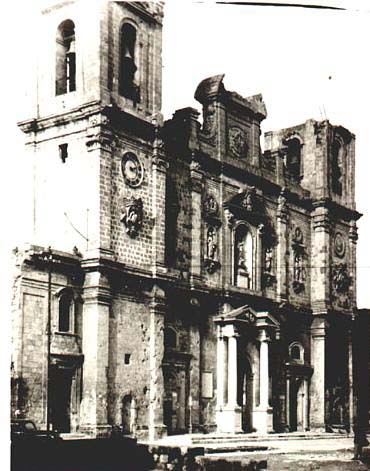 Remains of Sanglea Church after the raid on HMS Illustrious |
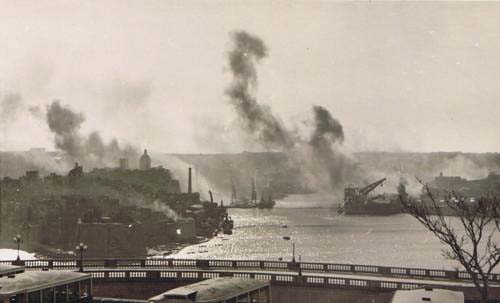 Bombing raid on HMS Illustrious |
A further attack was planned in Sicily but on the
night of the 23rd Illustrious sailed out of the harbour bound for the
safety of Alexandria. She was able to make 20 knots & moved so fast
she missed her escort cruiser squadron which were heavily bombed.
Illustrious received further repairs before setting sail for Norfolk,
Virginia, USA for a complete refit. She was replaced in the Mediterranean
by HMS Formidable, another armour decked carrier.
During June, July and August aircraft and submarines based on Malta had
sunk 58% of enemy shipping that had sailed from Europe to Africa and thus
the Axis decided that Malta must be knocked out at any price.
In December the Luftwaffe built up considerable strength
in Sicily and on 31st December there was an 'invasion imminent' warning
in Malta. The attack did not materialise. flattened and wrecked by the
full onslaught of the Axis power, Malta stood up and showed its tormentors
a clenched fist of resistance. By October of the same year Hitler issued
the remarkable order to Paratroop General Kurt Student to prepare, in
cooperation with the Italians, for operation "Hercules", the
conquest of Malta from the air -- an airborne assault that fortunately
never materialized.
 Hudson Transport at Luqa 1941 |
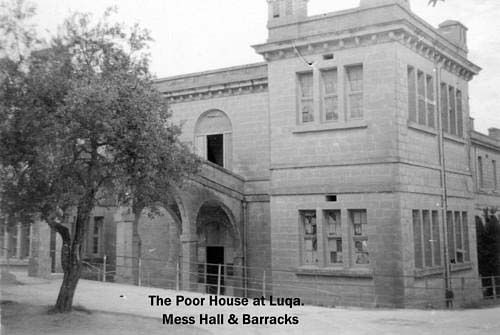 Luqa Mess Hall |
The Lascrais War Rooms
The Lascrais War Rooms complex originates from the
early stages of WW2 when an old communications tunnel, dug by the Knights
Templars in the 1700's, running across under the Upper Barracca Gardens
from Battery Street to the Valletta Main Ditch was converted into a Sector
Operations Room by the Royal Engineers for Royal Air Force use. From here
the movements of enemy aircraft could be tracked and plotted on a large
map to facilitate air and ground defence coordination. With the intensity
of the war, more space was excavated to make more room underground for
communications and radar tracking facilities. Late in 1940, the Royal
Navy war room at Fort St. Angelo made its way to this complex along with
that of the artillery's anti-aircraft defence. The coast artillery room
remained where it was in the crypt under the then Garrison Church now
the Exchange Building at Castille Place, Valletta.
During this period, the situation under the Upper Barracca was described
as crammed and unbearable. This led to the authorities to convert a massive
underground tunnel across from the Lascaris Tunnel in the Main Ditch into
a new and modern war room complex. This tunnel was originally excavated
by the Royal Engineers as an underground dormitory for those working at
the War Rooms. The long tunnel allowed for the placing of all necessary
operation rooms parallel to each other supported by as many offices as
necessary. Each one of them was provided with a separate entrance to preserve
secrecy. In the new war room complex there were an Operations Room for
each of the following along with a Filter Room for the sifting of radar
traffic and a Combined Operations Room for all services: Royal Navy, Anti-aircraft
Artillery, Royal Air Force and a Combined Operations Room. The new complex
opened for business in February 1943 in time for Operation Husky - the
invasion of Sicily in July 1943. The new Lascaris War Rooms served as
the joint Allied HQ under the Command of the US General Eisenhower. Assisting
him were Generals Montgomery and Alexander, Admiral Cunningham and Air
Marshal Tedder in command of the allied navies and air forces respectively
The following are photographs from the refurbished war rooms which depict
the operations undertaken at that time:
 |
 |
 |
 |
 |
 |
1942
The year which now opened was to be a momentous one.
 |
 |
 |
 |
Night Raid over Malta - Tracers, Floodlights and Flares light up the sky

January and February saw the heaviest rain of the winter
of 1941/42 but it did not deter the attacks on Luqa, Valetta, Birkirkara
and Hanrum. The first bombing attacks were cautious and tentative with
Italian Savoia bombers being used and these accompanied by large numbers
of fighters would attack several times a day. The first fatal casualty
by enemy action was recorded on 8 Feb 1942 when 3457389 Fusilier Hopwood
H died of wounds received from a bomb on 5 February 1942.
March saw an increase in the enemy raids as they tried to neutralise the
aerodrome at Luqa together with Sliema and the dockyard at Valetta. This
represented a change in tactics as by this time nearly all British bombers
on the ground had been knocked out and fighter strength was insignificant
compared with the numbers of aircraft the enemy were able to muster. The
Luftwaffe now became more confident and began to put over mass attacks
sending over waves of up to 80 bombers with heavy fighter support. The
first raids concentrated on Ta Kali aerodrome rendering it unserviceable
for many days doing great damage to aircraft on the ground. Next they
concentrated on Luqa and Hal Far aerodromes and thus the 11th Battalion
were strenuously employed in their maintenance and repair. Air activity
was continuous and the British squadrons were reinforced with a number
of spitfires. Whilst there were several casualties no fatalities were
reported.
Blitzed Valletta

|
Luqa Airfield taken from a Wellington Bomber
1942
 |
 |
 |
 |
 |
April On the 1 April 1942 there were 8 serviceable Spitfires and 19 serviceable
Hurricanes, a number which had fallen to 0 by the 14 April. This month
saw the continuation of the mass continuous raids by the Luftwaffe with
the bombing rising in intensity with no less than 6,728
 This picture of Takali aerodrome was taken by a reconnaissance plane on the 29th April when the Luftwaffe attacks were reaching their crescendo. The bomb craters cover the landing ground almost obliterating the runway. The protective pens round the field for aircraft are mainly empty. This was the domain of the 11th Battalion. |
 |
 This German reconnaissance photograph shows a section of Luqa aerodrome the bomber airfield. Damage and targets include destroyed aircraft, empty pens and twin engine bombers. This was the main area of responsibility for the 11th Battalion. |
TaQali Airfield
 blow up on right of aircraft shows roller used to level filled holes |
tons of bombs falling on the Island this month with severe damage being inflicted in Sliema and Valetta Grand Harbour and surrounding area (3,156 tons in April) together with the aerodromes at Luqa (805 tons in April), Takali (841 tons in April) and and Hal Far for which the 11th Battalion were now providing defence and maintenance. On 24 April 1942 two hospitals were bombed at St Andrews by the Luftwaffe despite them being clearly marked with a red cross. The losses to the aircraft of the Luftwaffe were now becoming significant. The 11th Battalion were mainly responsible, but not entirely, for the defence and maintenance of the aerodrome at Luqa repairing runways, preparing dispersal bays and widening taxiways. The Battalion HQ was at Birkirkara. Jack Eastham recalls "As you looked out over the Grand Harbour you could see the brightly illuminated flashes of the anti aircraft guns and the Stuka dive bombers descending into it. There were brave men on both sides of the conflict".
On April 9, 1942, during an afternoon air-raid, a 200 kg Luftwaffe bomb pierced the dome (two others bounced off) and fell among a congregation of more than 300 people awaiting early evening mass. It did not explode. Its replica is now on display inside the rotunda under the words Il-Miraklu tal-Bomba, 9 ta' April 1942
 |
 |
 |

A 3” mortar laying a smoke screen in a demonstration
 |
Kingsway from the Post Reale, Valetta showing
the bomb damage incurred. On the right the ruins of the Opera House
|
|
Image from the cockpit of a plane with a column
of smke rising in in the upper centre from a bomb roped near a church
|
 |
 |
A 40mm Bofors gun and crew with a Destroyer
entering the Grand Harbour
|
|
Cruiser Tank and Bofors gun being unloaded
in the Grand Harbour
|
 |
 |
Soldiers with pick and shovel clear bomb damage
in Kingsway, Valetta
|
|
A Matilda tank on exercises in the country.
Note the distinctive stone wall camouflage |
 |
 |
While the pilot looks on airmen and army personnel
refuel and rearm his spitfire
|
|
Soldiers prepare cartridge belts for spitfires
|
 |
 |
Filling bomb craters at Luqa Aerodrome
|
|
On 15th April 1942, King George VI awarded
the island the George Cross,
the highest civilian medal, for its people’s bravery and heroism. "To honour her brave people, |
 |
By May the situation had become very serious. The dockyard
had been put out of action, the enemy had complete control of the air
and by the changed tactics of attacking AA sites, army barracks and camps
it was clear that an invasion was imminent. Ammunition was running out
and no convoys had been able to get through for some time.
Jack Eastham recalls “During the raids on Luqa there were no air
raid shelters so the Company occupied slit trenches with the bren guns
mounted on suitable tripods. Sometimes the aircraft seemed so low you
could almost touch them. I saw a lot of enemy aircraft shot down but I
have no idea if any of them were due to our shooting”.
Succour came when 50 Spitfires were flown in from the US Aircraft Carrier
Wasp but most of these were destroyed on the ground before they could
materially affect the situation. Unknown to the enemy a large number of
spitfires had been flown in on the 9 May and the next day HMS Welshman
arrived with much needed ammunition which was hastily unloaded and distributed.
When the next attack came the Luftwaffe were met with 60 Spitfires and
an enormous AA barrage. This battle of 10 May marked the end of the mass
bombing on Malta.
 German Plane over Grand Harbour |
 Messerschmitt 110.s Attacking Convoy off Malta |
|
|
|
 Spitfire – This type also flew in the Italy Campaign in 1944 |
|
 Floriana After Bombing Raid |
 Taqali After Bombing Raid |
 Fort Manoel Under Bombardment |
June saw Luftwaffe activity change as the raids were
now using bombs with shorter fuses resulting in many bombs, which although
armour piercing, were ineffective as they exploded shortly after
leaving the aircraft. The island, however, continued to receive much damage
and casualties both with the Battalion and the civilian population. At
this time a number of Maltese scouts aged between 14 and 19 were to be
attached to the fuel and ammunition dumps to act as messengers. These
scouts would aid communication as they could speak both English and Maltese.
July saw an increase in the air attacks generally raids of nuisance value
but despite this the success of the spitfire interception was such that
on average 8 planes were being shot down in each raid with many more being
damaged so badly it was unlikely that they would regain their bases. This
resulted in a change of tactics with the bombers either coming in much
lower or much higher, the latter resulting in aiming problems causing
much wider casualties and destruction of property. These losses caused
a lessening of the raids with the result that the aerodromes were compromised
much less. On 25 July Major Derek Wooldridge Lister was awarded the Military
Cross by his Majesty the King.
The War Diaries record that a total of 153 planes were shot down in the
month and that as a „result of hitting back. the spirit of the men
had significantly improved.
August brought fewer raids by the Luftwaffe although those that did materialise
were significant. The bombers were intercepted by fighters and although
there were some British casualties serious damage was inflicted on the
Germans. One continuing concern is the number of civilians injured by
tampering with unexploded bombs. Typical meals recorded in August were:
Servicemen Breakfast Hard biscuit Thin slice rank looking bacon Lunch
Watery soup with few bits of cabbage Supper 1 small anchovy 1 teaspoon
jam 1 boiled sweet Civilian Breakfast ¼ slice stale bread Lunch
Watery soup with few bits of cabbage small portion watery goat stew Supper
Scraps, if lucky – probably nothing
Jack Eastham recalls “The bread had to be sliced evenly so as to
remain fair and quite often breakfast was only half a „soya link.
sausage and if you were lucky half an ounce of bacon – can yhou even
imagine half an ounce of bacon – still everyone wa suffering including
the local population”.
The civilian population were more and more dependent on communal feeding
as the amount of destroyed property increase resulting infeeding kitchens
being established to ensure at least one good meal a day when the diminishing
supplies allowed.

Civilians Queuing outside a Factory food Kitchen
Operation Pedestal was organised to supply Malta with essential supplies
in which the oil tanker Ohio was to play a significant part. Forty-eight
hours after Ohio had been transferred to British registry, her crew was
completed. The ship's company numbered seventy-seven, and it included
no fewer than twenty-four naval and army ratings to serve the guns. The
ship was then moved to King George V Dock, and the Oerlikon and Bofors
armament was placed aboard and fitted. After the disastrous failure of
the mid-June convoy, it was questioned if Malta could hold out on the
meagre supplies rescued from 'Harpoon-Vigorous', until another convoy
could be organized.
The Convoy entered Gibraltar in heavy fog on August 10. The day after,
four torpedoes from German submarine U-73 sank the aircraft-carrier HMS
Eagle, killing two-hundred-and-sixty men, and losing all but four planes.
On this day, German bombers attacked the convoy. On August 12 twenty Junkers
88s attacked the convoy, while a further combined strike by one-hundred
German and Italian planes attacked the merchantmen. It was during the
ensuing mayhem that the tanker was torpedoed by the Italian submarine
Axum[12] and caught fire. The Ohio was torpedoed amidships, where a huge
pillar of flame leapt high in the air above mast height. Ohio seemed to
be out of control; Captain Mason ordered the engines to be shut down,
with all deckhands available putting out the fire with the deck water-lines.
Lighted kerosene bubbled up from the fractured tanks, while little gouts
of flame spattered the deck on to a distance of thirty yards from the
blaze. Fortunately however, the flames were put out and the tanker managed
thirteen knots after being repaired. The blast destroyed the ship's gyro
and brought the magnetic compass off its bearings, while the steering
gear was lost, forcing the crew to steer with the emergency gear from
aft. A hole, twenty-four feet by twenty-seven feet, had been torn
in the port side of the amidships pump-room. The blast had also blown
another hole in the starboard side and the compartment was flooded. There
were jagged tears in the bulkheads and kerosene was bubbling up from adjoining
tanks, seeping in a film up through the holes in the hull. The deck had
been broken open, so that one could look down into the ship. From beam
to beam the deck was buckled, but the ship held together. Another sixty
Stuka dive bombers attacked the convoy, focusing on Ohio.[10] A series
of near misses ensued as the tanker approached the island of Pantelleria.
Bombs sprayed the decks of the tanker, while aircraft machine-gunned the
deck. One exceptional near miss occurred when a bomb buckled the tanker's
plates and the forward tank filled with water. The three-inch (76 mm)
gun at the bows twisted in its mountings and was put out of action. A
formation of five Junkers 88 was broken up by the tanker's anti-aircraft
guns, with the bombs falling harmlessly in the sea

The Italian submarine Axum's torpedo strikes the tanker on her port side
Ohio was sinking not much more than forty-five miles west of Malta. Under
the protection of the Spitfires, the danger of enemy attacks receded.
After the tow line was parted, the Ledbury, still secured to the Ohio
by a heavy wire had been pulled round by the heavy yawing tanker, and
had ended up alongside Penn, facing wrong way. After a quick analysis
of the possibilities, it was decided to tow the tanker with a destroyer
on either side of the tanker. Bramham was immediately ordered to make
fast to port, while Penn remained coupled to the starboard side. The speed
was increased and kept to five knots, while the deck of the Ohio was awash
amidships. Now under the protection of the coastal batteries of Malta,
the group of ships were slowly heaving around the island, approaching
the Grand Harbour. The coastal batteries fired on a creeping U-Boat conning
tower, and scared off a group of E-Boats. Slowly, the group approached
the tricky approach towards the harbour, near Zonqor Point. Here the group
ended in the approaches of a British-laid minefield. At 6 AM, with Ohio
still hovering on the edge of the minefield, the situation was eased by
the arrival of the Malta tugs. With destroyers still linked on either
side of the tanker, these sturdy ships made fast ahead and astern, and
the tanker was soon proceeding up the channel to the Grand Harbour entrance.
 The damaged tanker, supported by Royal Navy destroyers HMS Penn (left) and HMS Ledbury (right) |
 The damaged tanker Ohio enters the Grand Harbour |
There, a fabulous welcome awaited them. On the ramparts
above the wreck strewn harbour, on the Barracca, St Angelo and Senglea,
great crowds of Maltese men and women waved and cheered and a brass band
on the end of the mole was giving a spirited rendering of Rule Britannia.
Captain Mason, however, standing at the salute on the battered bridge
of the Ohio, could spare no moment's thought for the pride of bringing
the ship to harbour, since the creaking plates showed that the Ohio might
still end at the bottom of the Grand Harbour.
Pipes were now hauled aboard and emergency salvage pumps began to discharge
the kerosene. At the same time, a fleet auxiliary, the Boxall, began to
pump the 10,000 tons of fuel oil into her own tanks. As the oil flowed
out, the Ohio sank lower and lower in the water. The last bit of oil left
her and simultaneously her keel settled on the bottom.[26] Her captain,
Dudley William Mason, was subsequently awarded the George Cross. After
Ohio reached Malta, the ship broke in two from the damage it had sustained.
There were insufficient shipyard facilities to repair the tanker, so the
two halves were used for storage, and later barracks facilities for Yugoslavian
troops. On 19 September 1946, the two halves were towed ten miles (16
km) off the coast, and sunk with naval gunfire. The aft section sank first,
followed by the forward half.
Jack Eastham recalls the spectacle ¡°I have never seen such
euphoria as the ship arrived. The decks were almost submerged but what
a timely arrival¡±.
September was a quiet month with little or no air raids allowing the 11th
Battalion to continue with their work. On the 25 September the Battalion
HQ moved from Birkirkara to the caves area vicinity of CREMCWA FARM. On
28 September, the George Cross recently presented to the Island was put
on display at Luqa Village.
October saw a number of heavy raids in what seemed a last chance for the
Luftwaffe but these were largely ineffective with the island defences
proving an adequate solution. The 11th Battalion now provided a guard
at night at Luqa aerodrome to stop what seemed like pilfering of small
components from the aircraft. News of actions in Italy improved the Battalion.s
spirits.
November saw only sporadic bombing raids which did not inflict any significant
damage. There was some concern by the 11th Battalion that there was unrest
within the civilian population in that they believed the scarce rations
were being given to the army in preference to them. The 11th Battalion
were suffering health problems and weight loss due to the constant diet
of tinned food. On 6 November 52 assorted planes were delivered without
interference and on 20 November the long awaited convoy containing 4 Merchantmen
arrived following a relatively easy passage. By the end of November the
enemy air attacks were thought to be negligible.
December HMS EURYALUS is now based in Malta and is the successor to the
cruiser of the same name from which the 1st Battalion landed in Gallipoli
in 1915. The ships bell bears the regimental crest.
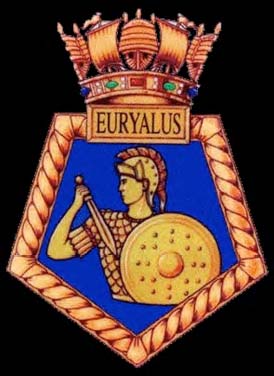 |
 |
Merchantmen and takers arrive and the population have a more upbeat optimism. Rations are increased to the delight of the 11th Battalion. The year ends with offenses from the forces in Malta against enemy targets and almost insignificant enemy air strikes.
1943
January Enemy activity is very light over the island and the 11th Battalion continue with their duties at Luqa. There is an outbreak of Infantile Paralysis about 9 Januar and the Battalion is banned from visiting bars, cinemas, etc. There are a number of sector changes for the companies and the disbanding of R Company with the resultant reallocation of men. Late enemy activity over the Island but driven away by AA fire.
The Lascaris War rooms were used by the joint command to plan the invasion of Sicily.
With the successful North Africa Torch landings behind them and the gradual clearance of Axis forces from Tunisia underway the resources were becoming available to undertake a series of amphibious landings in the Mediterranean. The ambitious "Round Up" (Normandy) was still not feasible so the objective of the next phase in the conduct of the war was to tie down Axis forces thus relieving pressure on the Eastern (Russian) front, and to force Italy out of the war. This was agreed at the Casablanca conference of January 1943 although for a while the Americans were inclined towards increasing pressure in the Pacific and later attacking Germany directly. In the end it was agreed to plan for a large scale assault via the periphery of Europe, or as Churchill preferred to call it "the soft underbelly of Europe" - initially Sicily.
General Guzzoni had 12 divisions - two German and 10 Italian to defend the island; five of the latter were infantry and five immobile coastal defence divisions. The garrison was 350,000 strong but included only 35,000 Germans and even they were not fully mobilised. Beach defences, including pillboxes and barbed wire, were less formidable than those encountered in Normandy the following year and modern tanks were relatively few in number. However the rugged rolling country favoured the defenders. The Allied Commander was General Eisenhower supported by Admiral Cunningham the Sea Forces Commander. General Alexander was Land Forces Commander and Air Marshal Tedder was Air Forces Commander.
The original Allied plan was to launch two widely separate landings in the north-west and south east of the island. General Montgomery objected on the grounds that this approach violated the principle of a combined and closely coordinated force. The plan was changed with the British 8th Army landing on the south east of the island and the US 7th Army landing on the south.
There were 2,760 ships and major landing craft converging on their rendezvous near Malta. They were from the River Clyde in Scotland, from Norfolk and Virginia in the USA and from ports from Beirut to Algiers in the Mediterranean. Seven and a half Divisions and all their equipment were at sea and eager for action.
February Continues with little to report. Convoys arrive and the 11th Battalion are allocated appropriate duties. The outbreak of Infantile Paralysis is now under control and the cinemas are about to re-open. Night and other exercises continue.
March Little to report for the Battalion. They continue to man the fuel and ammunition dumps. The 25 March sees enemy activity over the Island and the sirens sound for the first time in 22 days. 1st Brigade (comprising 2 Devons, 1 Dorsets and 1 Hamps) leave Malta.
April The Battalion hands over all Command Guards and Working Party commitments to 2nd Battalion Queen's Own Royal West Kent Regiment. Battalion continues to man fuel dumps and convoy duties. On 14 April MV King Edwin, loaded with Octane, Benzene, ammunition and food, in the Grand Harbour exploded and went on fire which was still reported as burning on 16 April. On 18 April the Battalion won the final of the Inter Regimental Knockout football competition against R.A.M.C., by 3 goals to 1. Training continues.
May The Battalion continue with their military exercises. A convoy consisting of 4 destroyers, 5 Merchantmen and 1 troopship arrive in Valetta. The Battalion takes over the Guard at the Governor.s Residence, San Anton Palace. The Battalion takes over POW guard of prisoners sent from North Africa, some of which fought the
2nd Battalion Lancashire Fusiliers. Various degrees of training carry on. Some increased enemy air activity towards the end of the month.
June The month sees much activity as convoys arrive throughout the month. The Battalion continues with company relocation and hand over of some of the fuel and ammunition dumps. On 20 June HM The King visited Malta acknowledging the cheers of the Battalion which lined the route. He left later the same day aboard HMS Aurora from the Grand Harbour.

HMS Aurora
 |
 |
 |
The month comprised mainly regular duties.
C Company was involved with the secret building of camps to house the 1000.s of servicemen for the invasion of Sicily. These camps were in some remote places for security reasons. Jack Eastham recalls that These camps were tented villages and we erected lots of tents. We were not going with the invasion but at least we played a small part.
July Saw the introduction of anti saboteur patrols as there is now considerable troop activity through Malta in readiness for the invasion of Sicily. The naval bombardment can be heard in Malta and reports were made of sightings of the gun flashes. An air raid of some 15+ bombers attack Sliema and St George.s Bay dropping bombs. Lt Colonel D F Page became the Battalion.s firs casualty of 1943 when hit in the head by a bomb splinter. At the end of the month other raiders cross the Island being engaged by the AA resulting in no bombs being dropped.
On the 9th/10th July the British 8th Army landed on the south east of the island and the US 7th Army landed on the south.
The disposition of the forces was as follows;
Force A (ex force W) under the auspices of Rear Admiral Troutbridge on the Bulolo comprising Dempsey's 13th Corps (5th & 50th Divisions) which was to land between Syracuse and Avola on the south east coast,
Force B under the auspices of Rear Admiral McGrigor on the Largs. 231 Independent Brigade was 15 miles to the south at Marzamemi and Sir Oliver Leese's 30th Corps (including the 51st Highland Division) were allotted the southernmost tip of the island south west of Cape Passero.
Farther to the west and round the corner of the island was Rear Admiral Sir Philip Vian's Force V and the 1st Canadian Division, both under Leeses's 30 Corps. All three Rear Admirals came under the command of Ramsay who was on the Antwerp,
Further still to the West between Scicli and Licata, with the vital airfield at Gela in the middle, were Divisions of the US 7th Army and US 11 Corps . They were to land on three beaches "Cent," "Dime" and "Joss" with a division allotted to each plus an armoured brigade for "Joss." The remainder of the Armoured Division to which it belonged was kept afloat as a reserve. The American Operation was under the command of Lieutenant-General Patton and Vice-Admiral Hewitt.
In addition a number of special operations were in place. The first was No 3 Commando and the South African Squadron of the SAS to the extreme right near Syracuse. The second involved Nos 40 and 41 Royal Marine Commando, under Laycock, to the left of the Canadians near Pachino. The third was a number of airborne landings, both British and American, to speed up the capture of airfields.
There were potential conflicts of interest between the services in the timing of the operation. On the one hand the parachutists needed bright moonlight conditions but the thousands of ships lying off shore felt vulnerable to air attack in such conditions. However since the Allies now had air superiority the matter was resolved in favour of the parachutists.
An Allied deception plan convinced the Germans that Greece or Sardinia were the most likely targets for the invasion and the CIC of the Luftflotte 2 concentrated his resources to the defence of the latter. Pantelleria and Lampedusa had surrendered in mid June after sustained and heavy aerial bombing by the Allies and the bombing of Sicilian Airfields, in the 7 days prior to Husky, had been so successful that not a single Axis plane put out to harass convoys approaching Sicily.
With the conquest of Sicily it effectively meant that the air attacks on Malta would cease as the German and Italian planes did not have the range to fly from their bases in Italy.
Husky was a great triumph and Mountbatten could not disguise his delight at the important part Combined Operations had played in the operation. For his part Hewitt's report included 178 recommendations and ended with the warmest praise for the co-operation and comradeship between the Royal Navy and that of the USA. He recalled that it was only barely 14 months since he had visited Admiral King's office in Washington. They and their respective teams had shared much in the planning of the operation and the rewards were there for all to see.
Outcome (positive): Allied victory. With the capture of Sicily the Allies made ready for the invasion of Italy. 37,000 German and 130,000 Italian losses mostly prisoners. Gain of naval and air bases in the Mediterranean.
Outcome (negative): 31,158 killed, wounded or missing.
 The Fleet Sails |
 USS Robert Rowan Explodes |
 Troops on Deck |
August starts with the celebration of Minden Day with such celebrations as the circumstances will allow. The Battalion HQ moves to Ta Saliba. There is little enemy activity so the Battalion make the most of their time by training and vehicle and equipment maintenance. N bombs were dropped in this period.
September Sees the surrender of Italy and the order is issued not to fire on Italian Planes. On 14 September Major Markes arrives in Malta to take over command of the Battalion and on 17 September Lt Colonel Page D.S.S. leaves his command and the island of Malta. Again this quiet month allows traing and maintenance to continue also allowing army life to get back to normality with increased inspections.
October Is a quiet month allowing battle training and courses to take place. Battalion organises additional moves for HQ and other Companies. A period of heavy rain ensues with billets being flooded.
November and December Sees the completion of HQ moves to St Andrews. The month comprises day and night exercises and demonstration of battle techniques, parades and training. Winter dress now becomes order of the day.
On November 19th Winston Churchill together with Field Marshal Lord Gort and Vice-Admiral Hamilton visited Malta and Churchill was taken to see the devastation incurred in thedockyard and the shattered cities of Sanglea and Valletta. He drove through the Victoria Gate and onto the Palacer where a croud had gathered outside in the square. Churchill appeared on the balcony and saluted the crowd.
 Churchill at Sanglea Wharf |
 Churchill, Field Marshal Lord Gort and Vice-Admiral Hamilton |
1944
January, February and March continue to be months of consolidation, training, exercises and regular duties in the dockyard. Training at night intensifies and officers from the Battalion attend appropriate training courses. Weopan drills including grenade throwing continues.
April continues in much the same way until the 25 April when 389 Greek sailors are taken into protective custody and disarmed by the 11th Battalion. The situation deteriorated with the Greek mutineers causing concern and it was decided to segregate the worst offenders. 102 Greek Naval personnel were escorted to new protective custody at Ghain Snuber.
May Sees the end of the 11th Battalion.s tour of duty in Malta. They hand over their responsibilities to other battalions and move out of their barracks down to the docks to start the next phase of their war contribution.

11th Battalion Lancashire Fusiliers pictured at St Patricks Barracks prior to their leaving for Italy.
Jack Eastham, is sat 4th from left front row

Jack Eastham is 6th from left 2nd row
|
|
By 1942, the bitter struggle for control of the central Mediterranean reached its climax. To the German mind there was then no alternative: either Malta, the thorn on their side must fall, or the German Africa Corps under command of the legendary desert fox, General Erwin Rommel would be lost. Field Marshall A. Kesserling, C-in-C German Armed Forces in the area, decided Malta was too great a nuisance to be allowed to live. It was to be smashed, made silent and uninhabitable, then invaded. Accordingly he ordered a change in the German attack tactics on Malta, from single sorties or small formations, to carpet bombing by dense concentrations of bombers.
The entire "Fliegerkorps" in Sicily, consisting of three hundred fifty aircraft, was thrown against Malta with a vengeance, pouncing on any ship or plane which tried to succor the island. The Germans systematically selected one point after the other, and pounded away day and night, until each target was pulped out of existence. Bombs were dropped by the ton: by the hundreds of tons: by the thousands of tons. In April 1942 alone 6,730 tons of bombs were dropped, a dubious record of airborne wholesale destruction which still holds true to this very day. The German High Command thought the obliteration of Malta and its people was complete. But they were wrong. Under the crescendo of exploding bombs and mounting casualties, the hardened Maltese and their British comrade-in arms stood firm and fought back as best they could. However passionately Benito Mussolini and the German Armed Forces Operations Staff desired Malta's capture, the decisive factor again was Hitler's determination that no full scale invasion be attempted. Meanwhile in Malta, British Governor and C-in-C General Sir William Dobbie, was replaced by Field Marshall Lord John Gort V.C, of Dunkirk fame. This transfer of power signalled Britain's determination that Malta should not be allowed to die, for if it fell the Mediterranean sea would be lost and the North African campaign gravely imperilled. There were several attempts by the British navy to reinforce Malta with food, guns and ammunition. The larger and most significant of these convoys was code named "Pedestal". Some sixty surface ships and eight submarines set out of Gibraltar headed for the besieged island. So fierce was the ensuing sea and air battle that every single one of the ships was hit. One the "Ohio", a fourteen thousand ton American tanker was marked for special treatment. Hit and damaged by more blows any ship can endure, she made her agonizing way to Malta under constant air attack strapped between two escort destroyers, with a third vessel acting as her rudder. By autumn 1942 the German-Italian effort to subdue Malta came to a final end. The island now rearmed, resumed its former function as a deadly predator on the Axis supply routes to North Africa. The pendulum had swung again.

In September 1943, Admiral of the Fleet Sir Andrew Browne Cunningham, C-in-C Mediterranean, sent a radio message to the Admiralty in London, England, which read in part, "Please to inform your Lordships that the Italian battle fleet now lays at anchor under the guns of the fortress of Malta". In May 1945 the war in Europe came to an end, and with it Malta had earned a place of honour in the annals of world history.
 |
 |
 |
|
|
St George's Barracks, St Julians
St George's Baracks consist of two identical blocks built in the style typical of British colonial military architecture in the Maltese islands, and originally served as barracks of the Royal Engineers. In the centre on top of each barrack block is the British royal insignia in high relief |
|
St Andrews Barracks
|
 |
During the campaign in Malta 12 members of the 11th Battalion were killed and are buried at
Pembroke, Pieta and Mtarfa cemeteries. Captain D W Lister was awarded the Military Cross for a
bren gun duel with a low flying German fighter, Lt Thomas Broe MM (Click on Thomas's name to see his feature page) was was Mentioned in Despatches and
CQMS acting WO2 H W Marsh was awarded the British Empire Medal
 |
British War Graves Pembroke Cemetery
|
|
Entrance to Pembroke Cemetery
|
 |
 |
 |
 |
The Siege Bell War Memorial, Grand Harbour,
Valletta, Malta commemorates the victory of the Allied Forces
during the Second Siege of Malta from 1940 to 1943.
The 10 tonne bronze Great Siege Bell memorial was inaugurated by Queen Elizabeth and the President of Malta, Dr. Censu Tabone on 29 May 1992, the 50th anniversary of the awarding of the George Cross of Bravery to the island of Malta in 1942. It is rung daily at noon. The bell is mounted in a limestone tower. At the foot of the bell tower is a bronze figure representing the 7000 who died in the siege. The gallery contains pictures of the plaques. The memorial was built on the initiative of the "George Cross Island Association" based on the idea of a local member, Philip Pullicino. |
 |
Italy
Napoleon once said that the only way to invade Italy was from the top. The Allies did not heed his warning and paid dearly for every inch of ground. Battles compared in their sheer intensity and horror with those of World War One. At Anzio alone the Allies suffered 135,000 casualties and Monte Cassino, over 54,000. In Tunisia, another 45,000 casualties. 20 Victoria Crosses were awarded during the Italy Campaign - 5 at Cassino alone! So the legend goes, veterans of the Italian campaigns were called "D-Day Dodgers" by Lady Nancy Astor MP in a speech, after she received a letter from a disgruntled British soldier who signed it "D-Day Dodger". However she refuted the claim soon after in the 8th Army News.
On 21st May 1944 at 0555 hrs the Battalion left Malta from Lascaris Wharf aboard the French ship „Ville d.Oran. after having been stationed there since July 1941. The weather was hot and the visibility hazy. They sailed first to Syracuse in Sicily arriving at 1057 hrs and sailing for Naples at 1800 hrs after being addressed by Brig I de la Bere O.B.E.
 |
 Currency issued to British troops |
The battalion arrived in Naples on 22nd May 1944 at 0745 hrs without
incident and from there proceeded to a transit camp near the impoverished
village of Afragola, arriving at 1030 hrs, for a few days before proceeding
to No 1 I.R.T.D. at San Martino where they arrived on the 27th May 1944
at 1400 hrs and marched in behind the Battalion brass band. This again
was only a stopping off place and after several days on the 4th June
1944 the Battalion moved to Caserta Railway Station and board a train
for Taranto and Brindisi via Solerno and Portenza. A Party and Battalion
HQ go to 186 Transit Camp at Taranto and B Party go to Brindisi for
a further spell of garrison duties at one of the main distribution depots.
In July the Battalion left Brindisi for the staging area at Taranto
where, after a brief seven days and a pep talk from Major General Ayres,
it left for the Guards IRTD at Caserta, where the Battalion was split
into two companies, one to the Welsh Guards and the other to the Coldstream
Guards as a reinforcement unit. There was intensive field training until
the 11th August 1944 when to the surprise of everyone the authority
was received to revert to normal infantry and the Battalion again became
a fighting unit of the 1st British Infantry Division and were soon on
their way to the Italian Theatre of War after Capt (QM) T Broc equiped
the Battalion in seven days.

On the 20th August the Battalion moved to Afragola to regroup and re-equip.
Through Rome and Foligno the move north continued to Greave on the 25th
August, overlooking Florence, where the Battalion joined the 66th Infantry
Brigade at Grossino.
The 66th Infantry Brigade was a British Army brigade formed in Italy
on 20 July 1944. The brigade fought in the Italian Campaign until 27
January 1945 when it was shipped to Palestine and finally Syria where
it ended the war.
Commanders
Brig. M. Redmayne
Component Units
1st Bn. The Hertfordshire Regiment
2nd Bn. The Royal Scots
11th Bn. The Lancashire Fusiliers
On the night of 29th/30th August they crossed the Arno and onto the
outskirts of Florence where there were five killed and 18 injured on
the first day and one killed and seven injured on the second day, which
proved that sheer guts was not enough. The Brigade was now in position
on the northern bank of the Arno, patrolling against the Germans who
had mined everything possible, and the official report stated that the
Fusiliers' first efforts were creditable but costly. The Germans withdrew
to the Gothic Line
|
GOTHIC Line in the North Apennine Mtns. Germans
set up a defence line north of Rome along the backbone of the
northern Apennine Mountains. Again, the British attacked along
the east coast. The main crossing of the Apennines was at Il Futa
pass. This was heavily defended, so the main attack was at IL
Giogo Pass to the east. This fighting was described as an all
up-hill battle as several large peaks had to be assaulted. Both
the 5th & 8th Armies were drained of men as units were pulled
out for the invasion of Normandy and southern France. Without
sufficient reserves, the fighting drew to a stalemate as the second
winter in Italy set in.
|

German Tigre Tank
On the morning of the 1st September 1944 the Battalion acted as advanced guard to the Division as it moved forward in pursuit along Route 65. „B. and „D. companies crossed Monte Rinaldo through minefields without incident. Soon the Germans began laying down a mortar attack and „D. company received casualties with five dead and nine wounded. „A. and „C. companies were established on the outskirts of the village of Montorsoli and the whole Battalion was under heavy bombardment with „A. and „C. companies trapped in the open receiving casualties. They stayed in these positions until relieved by the “2nd Royal Scots on the night of 2nd September 1944. The Battalion moved back to Rovezzano for rest and reorganisation.


On the night of the 12th/13th September 1944 the Battalion moved to a concentration area at Borgo San Lorenzo where they were told that the 1st Division was to break the Gothic Line in the central sector with the 66th Infantry Brigade leading.
The 1 Infantry Division was a pre-war Regular Army formation, which was sent to France as part of the British Expeditionary Force. In March 1943, it was deployed to Tunisia and then used to secure the Island of Pantelleria. From there, it went on to Italy, arriving on 7 December 1943. The division landed at Anzio on the 22 January 1944 under the command of the U.S. VI Corps. It sustained heavy casualties during the battle for Anzio. It remained in the Anzio beach-head until the breakout. It then rested and refitted after its long period on front-line duty.
Commander Major General Charles Loewen
Comprising
2nd Infantry Brigade
3rd Infantry Brigade
66th Infantry Brigade
On the night of the 15th/16th September 1944 the 11th Battalion attacked on the right hand with .B. and .C. companies both achieving their objectives without much opposition. The following morning they pushed on to a commanding feature known as Pt.960 taking a few casualties. On the morning of the 16th September 1944 .A. and .D. companies were sent to extend the position by occupying two points on the right flank. .B. and .C. companies were viciously counter attacked on the morning of the 17th September 1944 but repelled the attack. The Battalion advanced the next day to Monte Ceppo with .D. company leading supported by
A Company on its right, both taking a few casualties.
On the 19th September 1944 the advance continued in heavy rain with the Tac HQ moving ahead to point 950 with B and C Companies in reserve. The main HQ is located at Il Monte. At 1400 hrs on the 20th September the Tac HQ moves onward behind B and C companies (Jack Eastham was in C company) with the objective to push along Bullock Route as the advance to the Contact Force reaching the lower slopes of Monte Carlozlano 1187 Metres by 1800 hrs without encountering the Germans. By 1900 hrs the Tec HQ together with B and C Companies run into heavy machine gun and mortar fire in the mist. This situation was made worse with the allied artillery falling short of their target and the Battalion took several casualties including Major Moir RA, Battery Commander killed. At first light on the 21st September 1944 the enemy artillery fire, reinforced by allied batteries falling short caused more casualties amongst the leading troops. The rest of the Battalion closed up on the leading companies taking up defensive positions on Monte Carlozanco. The weather had become very bad with heavy rain and mist making the evacuation of casualties over the steep, wet, slippery mountain paths painful and difficult. It was during this action on the 21st September 1944 that L/Corporal Jack Eastham was wounded in action, receiving shell wounds to his left arm. There is no information as to whether it was from the German artillery or the allied artillery shortfall.

|
Medals issued -1939 -45 Star, Africa Star,
Italy Star, Defence Medal, War Medal.
 |
On the 12th October 1944 he was evacuated as a hospital patient
to the UK and on the 10th March 1945 he was discharged from the army
being classified as unfit for any form of military service.
After the war, Jack went back o work as a conductor on the buses for
Oldham Borough Council. The Council had kept the last two tramways,
Shaw to Werneth and Hollinwood to Waterhead, open during the war because
of the petrol shortage and so until August 3rd 1946 when the last tram
ran, he worked on them. Oldham Corporation built a large new bus garage
behind the old tram sheds at mumps with a large open floor space providing
136,500 sq.ft. of open parking space with only three main pillars in
support. Because of his war injury he always wore a glove on his left
hand as he had difficulty with the circulation. He chose always to wear
clogs for work and tended to walk everywhere if possible. I do not know
if this was through choice or because he suffered from osteoarthritis
as a result of the war wound.


The Malta George Cross Commemorative Medal and the Battle for Malta
Commemorative Medal are shown below. Due to his ill health and disability
he was unable to attend the Island as a veteran but they have been purchased.

A great piece of work sent in to us by
R A Eastham MSc FRICS


